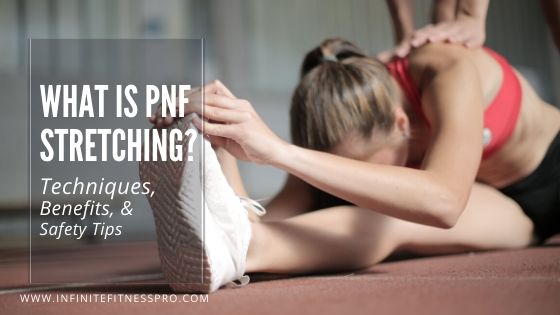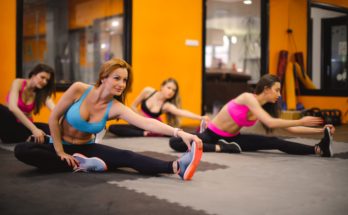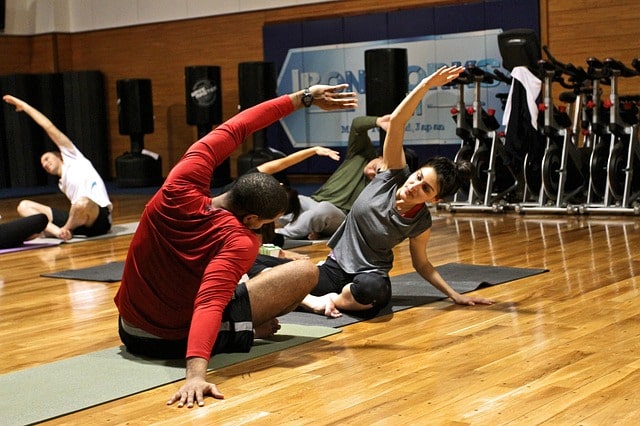Stretching is an important aspect of physical exercise. It improves flexibility and helps in preventing injuries during sports and exercises. There are various types of stretching techniques: dynamic stretching, static stretching, ballistic, and PNF stretching.
Different types of stretching techniques provide different benefits. In this article, we are going to look at the PNF stretching including its benefits and techniques.
What is PNF Stretching?
PNF stands for Proprioceptive Neuromuscular Facilitation. According to the IPNF Association, PNF stretching was developed by Dr. Herman Kabat in the 1940s. It was developed to treat neuromuscular conditions including polio and multiple sclerosis.
Definition: PNF stretching is an advanced method of flexibility training that includes stretching, hold and contraction of targeted muscles.
Initially, PNF stretching was used for clinical purposes. But now, due to its effectiveness, it is becoming popular in sports clubs and gyms.
PNF stretching strengthens your muscles, increases range of motion, flexibility, and hence improves workout performance. But make sure, you do it with proper technique.
PNF Stretching Techniques
All the techniques of doing PNF stretching revolves around mainly three things:
- a static stretch
- hold it for some time
- isometric contraction
However, there are proper ways to do that. Hence, to perform PNF stretches, it is better to have a partner or therapist. Here are the techniques of PNF stretching.
1. Hold-Relax
This PNF technique involves:
Stretch and hold: Putting a muscle in a stretched position and hold that stretch for some time (about 10 seconds). This can be called a passive stretch.
Contraction: Now without actually moving that muscle, contract it – like a gentle push against the stretch. This is also called isometric. Do it for around 5 or 6 seconds.
Relax: Now just relax the stretch, and then go for stretching again while exhaling. Try to make it deeper than the first one.
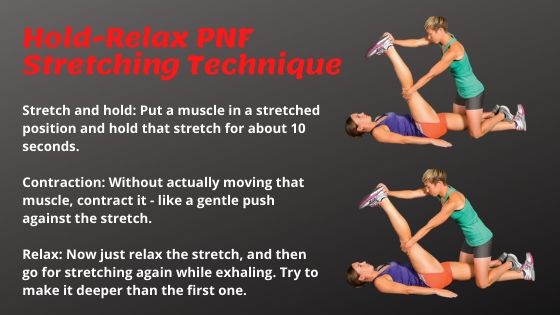
2. Contract-Relax
This PNF technique is almost similar to the hold-relax technique. The only difference in the contract-relax stretch is that instead of contracting the muscle without moving, contraction takes place while moving.
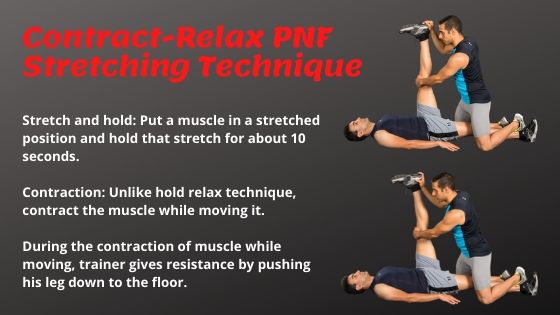
In the first figure you can see the athlete holding the stretch for 10 seconds.
Then he contracts the muscle while moving, and the trainer gives resistance by pushing his leg down to the floor.
3. Hold-Relax-Contract
The first two steps of this technique are similar to the hold-relax. However, the hold-relax-contraction technique differs in the third step.
In the third phase, instead of relaxing into a passive stretch, the athlete actively pushes into the stretch.
So these were the three PNF techniques. You can see the visual representations of some PNF stretches by the fasciologist Ashley Black.
Benefits of PNF Stretching
Here are the several benefits of doing PNF stretching.
Improves Range of motion (ROM) & flexibility
The range of motion is the distance in which a joint can comfortably move in a particular direction. You can perform PNF stretches on a daily basis to improve flexibility and range of motion.
PNF stretching can be used as an alternative or along with the traditional static stretching. In fact, some studies suggest that it is better than static stretching for increasing range of motion.
Boosts athletic performance
After a high-intensity workout, doing PNF stretching with your training partner can be very beneficial in improving athletic performance.
It helps in repairing the wear and tear that happened in your muscles due to a heavy workout. Also, stretching fastens the recovery process and prepares your muscles for the next workout.
Injury prevention and rehabilitation
PNF stretching elongates your muscles, increases blood flow, and removes tension in them. Hence, reduces the risk of injuries during sports and workout.
Some of the PNF stretching exercises also help in some serious sports injuries during the rehabilitation process.
How To Start
PNF stretches are an easy and effective way to increase your flexibility and range of motion (ROM). Rather than doing alone, it would be better to have a partner.
To improve general flexibility, Ashley Black recommends working on the long kinetic chains of the body. This include:
- Hamstrings
- Glutes
- Hip flexors
- Side fascia
- Back
These can cause a major impact on mobility. If you want to increase the flexibility of a particular muscle or area because of injury, then consult a physiotherapist first.
PNF Safety Tips
Here are some of the precautions and safety tips you should consider while doing PNF stretches to avoid any soft tissue injury.
Do it gently: Don’t try to overstretch the muscle by applying maximum force. To get the best results, do it gently.
Warm-up first: Prior to performing these stretches, make sure you have done a proper warm-up. It increases the body’s temperature and prepares your muscles for stretching.
Keep breathing: Don’t hold your breath, keep breathing slowly throughout the stretch.
Keep it simple: Just remember to stretch, breath, contract, and relax. Your neuro-muscular system will take care of the rest.
Summary
So this was the detailed and studies based article about PNF (Proprioceptive Neuromuscular Facilitation). Flexibility and range of motion are key for athletes and sportspersons. Also for bodybuilders and gym freaks, doing stretching exercises is very important to maintain flexibility.
PNF stretching is an easy and effective way to produce deeper stretches that increases flexibility. Make sure to do it with proper technique and consider all the safety precautions which are mentioned above.
Thanks for reading this far. I hope you like the article and learned something from this.
If you have any query related to fitness, just leave a comment below.

